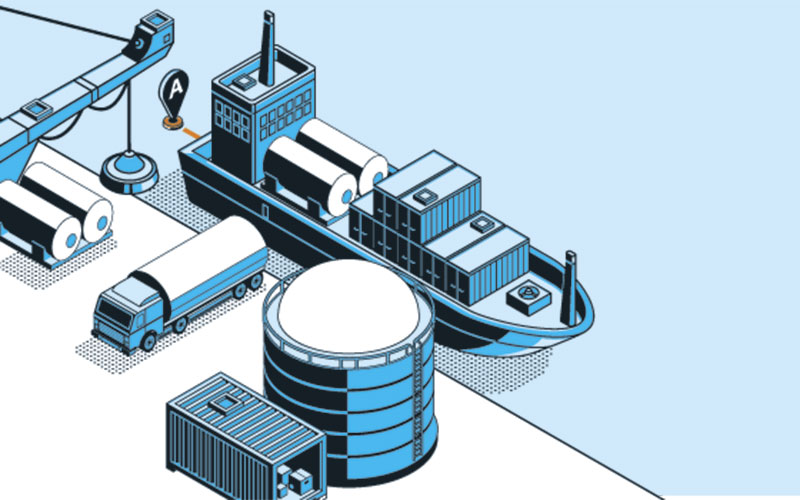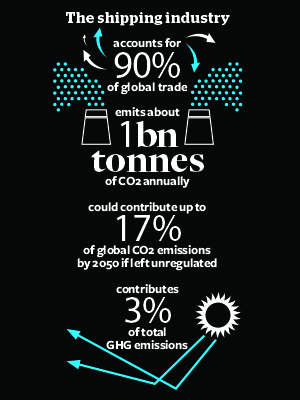Charting a course to sustainability
The backbone of world trade and globalisation, shipping is facing significant pressure from increasing environmental and climate regulation. Jeremy Bowden asks: what will it take to make shipping sustainable?

With COP24 in Poland last December, climate change remains high on the agenda, and that includes emissions from shipping.
International trade relies on shipping for about 90% of its freight transport, generating about 3% of total global greenhouse gas (GHG) emissions. Despite technological improvements, emissions continue to increase as trade increases.
So far, efforts to decarbonise the sector have been limited, but in April 2018, the International Maritime Organisation (IMO) made its first commitment to reduce carbon emissions, with a cut of 50% from 2008 levels now targeted for 2050.
Christos Chryssakis, Business Development Manager at EIC member company DNV GL – Maritime, noted that shipping was the first sector to have targets applied on a global basis by its own governing body. Because of its international nature, shipping is not included in the UN’s COP negotiations and the IMO’s move is likely to mean it stays that way. ‘The IMO is to establish a greenhouse gas study in 2019 and that will tell us how much closer to the [50%] target we are,’ he said.
Advanced data analytics could contribute to efficiency improvements by picking the best routes and speeds, even suggesting when an engine should be stopped
The IMO has also committed to a 40% improvement in CO2 intensity (a measure of ship and fuel efficiency) by 2030, compared to 2008, and a 70% improvement by 2050. Only two countries objected to the April deal: the US and Saudi Arabia. Mr Chryssakis said about half the 40% efficiency improvement had already been achieved, so the sector was currently on target to achieve its 2030 goals.
‘Vessels built now are much more efficient than in 2000 or 1990. The less efficient vessels will be out of the fleet by 2030,’ he said. Many of the improvements are being driven by minimum efficiency standards for new vessels. ‘Slow steaming also reduces fuel costs, and cuts emissions – and has been a major contributor to cuts so far.’
He said advanced data analytics would contribute to the efficiency improvement by picking the best vessel routes and speeds, or even suggesting when an engine should be stopped. Other new technical developments that improve efficiency include advanced paints to cut drag. And for calmer, short-haul journeys there are also advances such as the rotor-sail, which was developed by Finland’s Norsepower, and can cut fuel consumption by up to 20%.
Lower sulphur
Shipping is tough to decarbonise because it is difficult to use electricity for all but the shortest routes, due to the battery size and weight

In addition to its CO2 targets, the IMO is introducing challenging 0.5% sulphur rules for marine bunker fuel globally from 2020 (down from 3.5% now, although much of Europe is lower already). This is expected to lead to major changes in marine fuel use, as lower sulphur fuel oil and marine gas oil become far more expensive and high sulphur fuel oil (currently the dominant fuel) is no longer an option on its own, unless an exhaust gas cleaning system, a scrubber, is installed.
While more sustainable alternatives like liquefied natural gas (LNG), biofuels and hydrogen, will become relatively cheaper, Mr Chryssakis said most shippers would first look at the cheapest option to meet the sulphur limits, which in many cases is installing scrubbers. Scrubbers remove sulphur and other impurities, but do not cut CO2 emissions, which may actually rise as scrubbers require the use of a lot of auxiliary equipment. The vessel may also use fuel less efficiently as high sulphur fuel oil is cheaper.
Shipping is tough to decarbonise because it is difficult to use electricity (which is relatively easy to decarbonise) for all but the shortest routes, due to the battery size and weight. There are a few short-distance ferries in Norway, but they can recharge after each crossing. Longer distances require hybrids, which combine power and liquid fuels – for example, Norway-Sweden ferries and Stena lines from Sweden to Denmark. Globally the number of hybrids has risen from none a few years ago to 250 vessels currently, according to DNV GL.
LNG as a bridging fuel
In the absence of green electricity or a cheap zero-carbon alternative, using LNG as a marine fuel cuts some CO2 emissions, removes sulphur oxide and reduces nitrogen oxides impurities. So, this, combined with hybrids and further improvements in efficiency, is expected to be where the most progress in lowering the carbon intensity will be achieved in the short to medium-term.
‘Electricity is helping at the margin, otherwise more energy efficiency and cleaner fuels are needed,’ said Mr Chryssakis. ‘We think LNG will play a significant role. But the problem with LNG is that it only reduces CO2 emissions by about 25%.
This is welcome but not enough – it’s a medium-term solution… liquefied petroleum gas is also interesting. But as we get closer
to 2050, we will need to be more radical – including biofuels and synthetic fuels, which are currently very expensive.’
The first LNG vessel was launched in 2001 in Norway, with government support.
According to DNV GL’s database, the number of LNG-powered ships rose to 21 in 2010, and now stands at 133 LNG in operation, with another 140 on order – not counting LNG carriers. The transition will have to be through new builds as it is difficult and costly to convert ships to LNG, according to DNV GL, apart from those designed with an ‘LNG-ready’ option where conversion is relatively easy – of which there are 130 ships worldwide. Mr Chryssakis said larger container vessels were now switching to LNG, rather than just smaller ones as was the case previously.
To enable the switching, it is essential to establish the LNG infrastructure needed for convenient use. The UK already has three LNG import terminals – Dragon and South Hook in Wales, and Isle of Grain in Kent – and there are plans for more bunkering facilities. And in Germany, the government recently reversed its long opposition to LNG imports and gave financial backing to the country’s first LNG import terminal. It will also build a network of small-scale LNG bunkering facilities, with LNG expected to become key to reducing shipping emissions.
The EU also plans to spend almost €2bn on LNG infrastructure for waterborne transport over the next 10 years. Nevertheless, the International Chamber of Shipping recently warned that capital costs, limited infrastructure and the IMO’s long-term strategy could restrict the role of LNG as a shipping fuel. This is because shippers are likely to initially just focus on sulphur reduction, and then may switch directly to a zero-carbon option – rather than going through an intermediate LNG stage.
 Longer-term options
Longer-term options

Looking beyond 2030, Mr Chryssakis said the 2050 target would require lower-carbon or zero-carbon fuels. These would need to be developed outside or in partnership with other industries. For example, if biofuels were to be used, then their low-carbon credentials needed to be established by producers outside the shipping sector.
The mixing of biofuels into conventional marine fuels was only first permitted in 2017, at a maximum of 7%, and it still only represents a tiny fraction of sales.
Mr Chryssakis said the main challenges to biofuel use were the long-term sustainability and availability of the fuels themselves, and the risk of clogging fuel filters. He also noted that road fuels had minimum biofuel content rules, which pushed up prices. ‘If the IMO imposes minimum biofuel content levels, it could work. It would have to come through regulation… Most likely, the EU will not impose it unilaterally, but it might put pressure on the IMO.’
Hydrogen is also an option if it is produced using green electricity. However, it requires a large fuel storage space onboard the ship, which decreases range and means vessels must refuel more frequently.
DNV GL said three vessels would soon be using compressed hydrogen, including the HySeas III ferry in Orkney (which will use hydrogen produced using surplus wind and tidal power), and another in San Francisco. They are small ships but could prove the technology and lead to future expansion.
Most vessels are designed to last 40 years or more, which makes decarbonising the shipping sector a mammoth task that will take many decades to achieve. The process has already begun, but so far high oil prices and falling sulphur limits have been the main driver of change. It may take more severe carbon intensity regulation to meet the CO2 targets that lie ahead.
Image credit | Akin






Follow us
Advertise
Free e-Newsletter